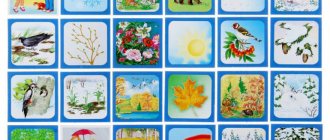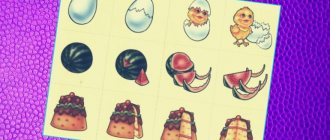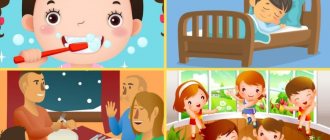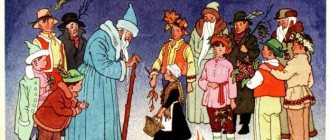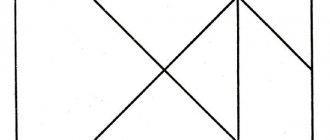Game rules and manufacturing instructions
Didactic game Seasons, download templates, educational games for children, games for comparing the seasons, smart Velcro
Didactic game Seasons 4 seasons.
The set includes 7 A4 sheets + 12 A4 sheets (enlarged version of the game) for by yourself .
The material is intended for educational activities with children aged 1 - 5 years.
By arranging the figures and creating his own funny story, the child will get acquainted with the seasons, learn to understand how winter, spring, summer and autumn differ from each other.
What's included:
4 sheets - four colorful playing fields depicting the seasons.
2 sheets with details of signs of each season (47 figures to cut out)
1 sheet with samples for the game.
MUSICAL AND DIDACTICAL GAMES FOR MIDDLE GROUP CHILDREN
Progress of the game:
The child pulls a thread of the color he likes from the box and, at the suggestion of the teacher or music director, sings any vowel sound at a height convenient for him. The sound lasts as long as the thread lasts.
Music cube
TARGET:
Development of singing skills.
TASKS:
Repeat the covered singing material, develop musical memory, consolidate knowledge about the signs of the seasons and the lullaby genre
Progress of the game:
The teacher, music director, or one of the children throws the dice. Depending on which side he turns, everyone sings a familiar song together. (Songs about winter, songs about spring, songs about summer, songs about autumn, songs about birds or animals, lullabies)
Fan of emotions
(allowance)
TARGET:
Development of intonation hearing.
TASKS:
Teach children to pronounce the same text with different intonations, reinforce the texts of finger games and songs
The teacher or music director selects one of the pictures on the fan of emotions and shows it to the children, asking them to speak a particular text with an intonation corresponding to the mood depicted in the picture (joy, sadness, surprise, anger).
Funny boots
(allowance)
TARGET:
Development of auditory attention
TASKS:
Teach children to hear the introduction or beginning and end of music,
teach children to hear the beginning of a new part in a contrasting 2- or 3-part piece of music, consolidate the material covered in music classes (musical-rhythmic exercises)
The child puts “boots” on the index and middle fingers of one or two hands. The action takes place at the table. The child listens to music, focusing not on the movements, but on the sound of the musical passage. And depending on the nature of the work, his fingers either run or march across the table at the right moment. (finger movements depend on the task at hand and the nature of the musical material)
Dance patterns
(allowance)
TARGET:
Consolidation of drawings of dance compositions.
Children of primary and secondary groups fix the simplest drawings and dance formations using a magnetic board. For the younger group this is: a circle, scattered around the hall one by one and in pairs. For the middle group: a circle, scattered around the hall one by one and in pairs, several circles, arranged in pairs in a circle. For the older group: arrangement around the hall in pairs scattered, several circles, arrangement in pairs in a circle, one at a time or in pairs in a checkerboard pattern or in lines, in two lines at opposite walls of the hall. For the preparatory group: several circles, arrangement in pairs in a circle, one at a time or in pairs in a checkerboard pattern or along lines, in two lines at opposite walls of the hall, arrangement diagonally, moving around the hall in a “snake”, etc. For older children and Preparatory groups can be asked to find their location on a magnetic board in a particular dance pattern.
Publication address:
How to play?
Select the playing field and help your child select the figures corresponding to the selected field.
By arranging the figures and creating his own funny story, the child will get acquainted with the seasons, learn to understand how winter, spring, summer and autumn differ from each other.
There are two game options available:
- The child arranges the figures according to the time of year.
- The adult creates a deliberately incorrect “story” and asks the child to find the mistake.
Game "4 seasons and 12 months"
Kindergarteners aged 3-4 years play, that is, the younger group.
Game objectives:
- teach the relationship between calendar times and a certain palette;
- develop mathematical skills - the ability to count to 4 and 12, divide geometric shapes into equal parts, name the months sequentially;
- develop memory, ability to concentrate and think logically.
For the lesson, you need to make a circle, divide it into 4 equal parts, paint each part with a color corresponding to the season: blue - winter, green - spring, yellow - summer, red - autumn. Children must guess which season each part of the circle belongs to and tell why this color was chosen.
For the middle age group, the task is made more complicated; each season of the circle is divided into 3 months.
"Seasons" for older preschoolers
For a preparatory group of preschoolers, you can play a game using computer technology. The teacher needs to prepare slides depicting pictures-answers to questions and riddles. From the presented pictures, children must choose the correct ones and click on them with a computer mouse.
The goal of the game is to form ideas about seasonal changes in nature and develop cognitive abilities through the use of computer technology.
Objectives of the didactic game “Seasons”:
- formation of ideas about the world around us, about the relationship between the changing seasons and objects of living nature and humans;
- consolidation of knowledge about the signs of spring, summer, autumn, winter;
- consolidation of knowledge about deciduous trees, hibernating animals, migratory birds;
- developing the ability to answer questions, solve riddles, speak competently and consistently;
- increase in cognitive activity;
- development of speech skills, increase in vocabulary;
- development of memory, hearing and vision perception, finger motor skills, ability to concentrate, and think logically.
The first group of slides concerns autumn. The teacher asks a riddle, the children guess what season is depicted. Next, the teacher asks questions: by what signs did the pupils identify autumn, what color are the leaves on the trees, what clothes are the people in the picture wearing, why are they dressed that way. The next slide shows autumn leaves, children must name which tree they came from.
The second group of slides concerns winter, children guess the riddle, tell how they identified winter, how people are dressed. On the second slide, from the animals presented, those that hibernate are selected. In the third of the presented pictures, choose the correct answers to riddles about a snowflake, a snowman, snowfall, frost, frost, icicles.
Next, preschoolers look at spring, guess the riddle, explain the choice of pictures, and tell how people are dressed. On the second slide, choose migratory birds from among the depicted birds. In the third of the presented images, choose answers to riddles about snowdrops, the sun, grass, streams, drops, rooks.
Next, the children look at summer, give an answer to the riddle, explain the choice of the picture, and explain why the people in it are lightly dressed. On the second slide, count the number of butterflies in forward and reverse order. At the third stage, edible mushrooms are selected from the presented mushrooms.
At the end of the game, the teacher asks the children to draw their favorite season.

